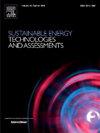Machine learning assisted revelation of the best performing single hetero-junction thermophotovoltaic cell
IF 7.1
2区 工程技术
Q1 ENERGY & FUELS
Sustainable Energy Technologies and Assessments
Pub Date : 2025-03-14
DOI:10.1016/j.seta.2025.104264
引用次数: 0
Abstract
In this work, Machine Learning (ML) techniques have been employed to explore the highest performing single-heteronunction thermophotovoltaic cell. Initially, traditional homo junction TPV cells have been explored using ML methodologies for the optimal material combinations. ML methods have notably been devoted to analyze the importance of each parameter in the model, thereby improving the comprehension of the system’s behavior and facilitating design optimization. Following this investigation, it has been found that Ge emerged as the most effective emitter layer when paired with the optimal base layer, InGaAsSb compound that possesses a direct bandgap of 0.53 eV. Subsequently, a p-Ge/n-InGaAsSb single-heterojunction TPV cell is introduced executing a device transport model featuring a p-n structure. This cell operated at black body (TBB) and cell temperatures of 1578 K and 300 K, respectively. Through meticulous optimization efforts, the performance of the TPV cell is significantly enhanced resulting in an impressive efficiency of 16.50 %. This efficiency is accompanied by a short circuit current, JSC = 15.53 A/cm2, an open-circuit voltage, VOC = 0.47 V, and a fill factor FF = 79.5 %. These findings suggest that this structural configuration holds considerable promise for the development of high-performance TPV cells.
机器学习帮助揭示了性能最佳的单异质结热光伏电池
在这项工作中,机器学习(ML)技术已被用于探索性能最高的单异功能热光伏电池。最初,传统的同质结TPV细胞已经使用ML方法进行了探索,以获得最佳材料组合。机器学习方法特别致力于分析模型中每个参数的重要性,从而提高对系统行为的理解,促进设计优化。研究发现,当与最佳基材层InGaAsSb化合物配对时,Ge成为最有效的发射极层,其直接带隙为0.53 eV。随后,引入了p-Ge/n-InGaAsSb单异质结TPV电池,实现了具有p-n结构的器件传输模型。该电池工作在黑体(TBB)和电池温度分别为1578 K和300 K。通过细致的优化工作,TPV电池的性能得到了显著提高,效率达到了令人印象深刻的16.50%。这个效率伴随着短路电流,JSC = 15.53 a /cm2,开路电压,VOC = 0.47 V,和填充系数FF = 79.5%。这些发现表明,这种结构配置对高性能TPV电池的发展具有相当大的希望。
本文章由计算机程序翻译,如有差异,请以英文原文为准。
求助全文
约1分钟内获得全文
求助全文
来源期刊

Sustainable Energy Technologies and Assessments
Energy-Renewable Energy, Sustainability and the Environment
CiteScore
12.70
自引率
12.50%
发文量
1091
期刊介绍:
Encouraging a transition to a sustainable energy future is imperative for our world. Technologies that enable this shift in various sectors like transportation, heating, and power systems are of utmost importance. Sustainable Energy Technologies and Assessments welcomes papers focusing on a range of aspects and levels of technological advancements in energy generation and utilization. The aim is to reduce the negative environmental impact associated with energy production and consumption, spanning from laboratory experiments to real-world applications in the commercial sector.
 求助内容:
求助内容: 应助结果提醒方式:
应助结果提醒方式:


